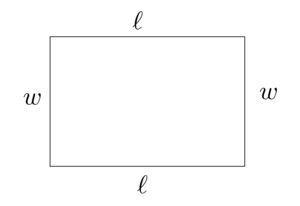Rectangle Perimeter 2
Task
The students in Mr. Nolan's class are writing expressions for the perimeter of a rectangle of side length $\ell$ and width $w$. After they share their answers, the following expressions are on the board:
- Sam: $2(\ell+w)$
- Joanna: $\ell+w+\ell+w$
- Kiyo: $2\ell+w$
- Erica: $2w + 2\ell$

Which of the expressions are correct and how might the students have been thinking about finding the perimeter of the rectangle?
IM Commentary
This task is a natural follow up for task Rectangle Perimeter 1. After thinking about and using one specific expression for the perimeter of a rectangle, they now extend their thinking to equivalent expressions for the same quantity.
The open-ended last question is intended to generate a classroom discussion led by the teacher. It is important for students to understand that correct reasoning can lead to expressions that appear to be different and that the properties of operations work for letters standing for numbers, just as they worked for numbers in earlier grades, and provide a way of showing that the apparently different expressions actually represent the same value.
Solution
-
Sam's answer is the same as discussed in task Rectangle Perimeter 1. He first added length $l$ and width $w$ and then multiplied the sum $(l+w)$ by two.
-
Joanna's answer is equivalent to Sam's answer. If we insert parentheses into Joanna's expression we see that $$ l+w+l+w = (l+w)+(l+w) = 2(l+w).$$
-
Kiyo's expression results in different values for the same rectangle than Sam's and Joanna's expressions do. For example, for $l=2$ feet and $w=3$ feet, Sam and Joanna's expressions give a perimeter of 10 feet and Kiyo's expression gives a perimeter of 7 feet. Kiyo's expression is missing one width of the rectangle. He added the length twice ($2l$) but the width only once ($w$). If he inserted parentheses around $(l+w)$, his expression would be the same as Sam's.
Erica's expression is equivalent to both Sam's and Joanna's expressions. If in Sam's expression we use the distributive property to distribute the factor of 2, and then use the commutative property of addition to switch the order of addition, we get Erica's expression: $2(l+w) = 2l + 2w = 2w + 2l.$
Joanna might have started at one side of the rectangle and then have gone around adding adjacent sides until all four sides have been accounted for: length + width + length + width.
Rectangle Perimeter 2
The students in Mr. Nolan's class are writing expressions for the perimeter of a rectangle of side length $\ell$ and width $w$. After they share their answers, the following expressions are on the board:
- Sam: $2(\ell+w)$
- Joanna: $\ell+w+\ell+w$
- Kiyo: $2\ell+w$
- Erica: $2w + 2\ell$

Which of the expressions are correct and how might the students have been thinking about finding the perimeter of the rectangle?
